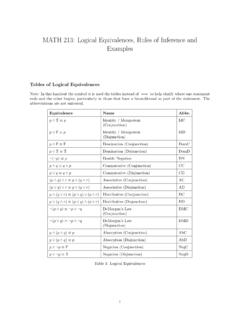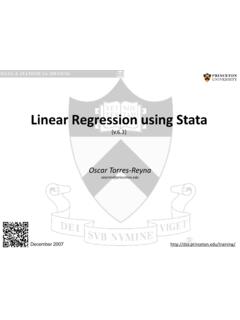Transcription of PREREQUISITE/PRE-CALCULUS REVIEW Introduction …
1 PREREQUISITE/PRE-CALCULUS REVIEWI ntroductionThis REVIEW sheet is a summary of most of the main topics that you should already be familiar with from yourpre- calculus and trigonometry course(s), and which I expect youto know how to use and be able to follow if I usethem in passing. If there are topics with which you don t feel as comfortable, suggested homework problems can befound on the web page, and we can also go over them during office ve tried to include most major topics, but there s a very good chance some things have been overlooked.
2 Feelfree to ask me if you don t see a concept listed and are wondering if it will come up in the GeometryWhat you need to know:(1) Notation for intervals, and how to plot them on a number line.(2) Properties/rules of inequalities.(3) How to plot (x, y) coordinates.(4) Distance Formula: The distance between two pointsP1= (x1, y1) andP2= (x2, y2) in thexy-plane is|P1P2|= (x2 x1)2+ (y2 y1)2(5) Equation of a Circle: An equation of the circle with center (h, k) and radiusris(x h)2 (y k)2=r2[Note, if you take the square root of both sides of this equation, you get the distance formula: the distancebetween the center (h, k) and a point (x, y) on the circle isr.]
3 ] In particular, if the center is at the origin(0,0), this equation becomesx2+y2=r2(6) Completing the Square: This comes up when dealing with circles andother conic sections, both in this classand later in calculus 3. Example 2 on page A17 shows how this can come up in a problem.(7) Slope of a Line: The slope of a nonvertical line passing through the pointsP1= (x1, y1) andP2= (x2, y2) ism= y x=y2 y1x2 x1=riserun(8) The Equation of a Line:(a) Point-Slope Form: An equation of the line with slopemthat passes through the point (x1, y1) isy y1=m(x x1)(b) Slope-Intercept Form: An equation of the line with slopemandy-interceptbisy=mx+b(you often have to use a known point on the line to solve forb).
4 These can be used interchangeably, but the point-slope form tends to arise more naturally in many of theproblems we ll be looking at (although we will still solve foryat the end of the problem).(9) Parallel and Perpendicular Lines:(a) Two nonvertical lines are said to beparallelif and only if they have the same slope12 PREREQUISITE/PRE-CALCULUS REVIEW (b) Two lines with slopesm1andm2are said to beperpendicularif and only ifm1m2= 1, , if theirslopes are negative reciprocals:m2= 1m1or, equivalently,m1= 1m2(10) How to sketch regions in the you need to know:(1) Converting from radians to degrees (probably won t use this much).
5 Rad = 180 ,so 1 rad =180 and 1 = 180rad(2) The basic definitions of trigonometric functions in terms of the sides of a right triangle:sin( ) =opphypcos( ) =adjhyptan( ) =oppadjcsc( ) =hypoppsec( ) =hypadjcot( ) =adjopp(3) The notation for the inverse trigonometric functions (and what these functions are):arcsin( ) or sin 1( ),arccos( ) or cos 1( ),arctan( ) or tan 1( )Remember that this the 1isinversenotation, not exponential notation, ,sin 1( )6=1sin( ),cos 1( )6=1cos( ),and tan 1( )6=1tan( )(4) How to find the values of all trigonometric functions at common angles using either the unit circle (seeFigure 1), or by using a 30 60 90 or 45 45 90 triangle (drawn the in the appropriate quadrant).
6 (5) How to find common values for arctan(x) (similar to previous item).(6) The graphs of the four trig functions shown in Figure 2:(7) The Reciprocal and Quotient Identities:csc( ) =1sin( ),sec( ) =1cos( ),cot( ) =1tan( ),tan( ) =sin( )cos( ),cot( ) =cos( )sin( )(8) The Pythagorean Identities:1 = sin2( ) + cos2( ),csc2( ) = 1 + cot2( ),sec2( ) = tan2( ) + 1(9) That sine is an odd function and that cosine is an even function, , thatsin( ) = sin( ) and cos( ) = cos( )(10) The Half-Angle Formulas:sin(2x) = 2 sin(x) cos(x)cos(2x) = cos2(x) sin2(x)= 2 cos2(x) 1= 1 2 sin2(x)(The last two equalities for cos(2x) come from using the Pythagorean Identities.)
7 PREREQUISITE/PRE-CALCULUS REVIEW3 Figure Unit Circle (image courtesy FCIT, )(a)f(x) = sin(x)Domain isR,range is [ 1,1].(b)f(x) = cos(x)Domain isR,range is [ 1,1].(c)f(x) = tan(x)Domainis{x R|x6=(2n+1) 2},range is ( , ).(d)f(x) =arctan(x)Domain isR,range is[ 2, 2].Figure of Trigonometric Functions You Should Know(11) The Double-Angle Formulas:cos2(x) =12(1 + cos(2x)) =1 + cos(2x)2sin2(x) =12(1 cos(2x)) =1 cos(2x)24 PREREQUISITE/PRE-CALCULUS REVIEW (12) These facts about sine and cosine: 16sin(x)61 and 16cos(x)61and so|sin(x)|61 and|cos(x)|61We may occasionally use the various addition and subtraction formulas involving trigonometric functions, butwe ll reference the book for those as you need to know:(1) The Vertical Line Test (see page 15 in the book).
8 (2) The graphs of the functions shown in Figure 3:(a)Constant,f(x) =a(a= shown).Domain isR,range isb.(b)Linear,f(x) =ax+b(y= 2x+ 1shown). Do-main isR,range isR.(c)Square,f(x) =x2 Domain isR,range is [0, ).(d)Cubic,f(x) =x3 Domain isR,range isR.(e)Square-root,f(x) = xDomainis[0, ),range is [0, ).(f)Cube-root,f(x) =3 xDomain isR,range isR.(g)Recipro-cal,f(x) =1xDomainis( ,0) (0, ),range is ( ,0) (0, ).(h)Abso-lutevalue,f(x) =|x|Domain isR,range is [0, ).Figure of Basic Functions You Should KnowPREREQUISITE/PRE- calculus REVIEW5(3) What a Difference Quotient of a functionf(x) is (and how to compute/simplify them):f(x+h) f(x)horf(x) f(a)x a(4) How to plot piecewise defined functions.]]]]
9 (5) What it means for a function to be even (f( x) =f(x) ) or odd (f( x) = f(x) ) - these will be usedoccasionally.(6) What it means for a function to be increasing or decreasing (thiswill come up a lot): Given a functionf(x)and some intervalI, f(x) is said to beincreasingonIiff(x1)< f(x2) for allx1< x2 I. f(x) is said to bedecreasingonIiff(x1)> f(x2) for allx1< x2 I.(7) Basics of polynomials: What a root or zero is, the Quadratic Equation (for finding the roots/zeros ofy=ax2+bx+c): b b2 4ac2a what we mean by degree, how the degree and leading coefficient effect end behavior.
10 (8) How to plot quadratics (such as those in Figure 4) by factoring or completing the square.(a)Factoring:y= x2+x+2 y= (x2 x 2) y= (x+ 1)(x 2), so we have aparabola opening downward withx-intercepts at 1 and 2.(b)Completing the Square:y=x2+ 2x+32 y= (x2+ 2x+ 1) 1+32 y= (x+1)2+12, so we havethe graph ofy=x2shifted left oneunit and Examples of Graphing Quadratics(9) What a rational function is, and how to find its domain.(10) Given two functionsf(x) andg(x), know how to find the composition function (f g)(x) =f(g(x)).Conic SectionsWhat you need to know.








